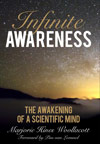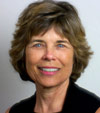|
|
|
A Scientist Awakening to Awareness
by Marjorie Woollacott, PhD
In the Complementary Medicine class I have taught to University of Oregon science students for the last ten years, I’ve found that of all the topics we cover, the students have the most difficulty accepting the concept of energy healing. All I have to do is say “energy healing,” and many of these students look shocked—as if they’re wondering why I would discuss such a thing in a science class.
Take Reiki, a type of therapeutic touch that originated in Japan and whose efficacy is increasingly studied by Western medicine. The healing associated with Reiki is believed to occur when an energy called the universal life force moves through the practitioner and into the person she is working with. Skeptics, including my pre-med students, typically believe this energy is only imagined and that studies supporting Reiki’s healing abilities are due to the placebo effect or the nurturing effects of touch.
On the other hand, many healthcare professionals, including clinicians at major medical schools, are advocates of Reiki’s healing power. Reiki is, for instance, used to aid the recovery of cardiac patients at the Yale University hospital. There a randomized controlled clinical trial (the gold standard of research) was performed to determine if Reiki sessions improved heart rate variability in patients with acute coronary syndrome. It was found that the Reiki group showed a significant improvement in heart rate variability from their baseline values, whereas the resting control group did not show any changes. This increase in heart rate variability—indicating an increase in autonomic function, which is quite beneficial—was virtually the same for Reiki as for propranolol, a pharmaceutical used for that purpose (Friedman et al, 2010).
This is just one of many studies demonstrating the benefits of Reiki. One review that examined twelve randomized controlled Reiki trials on a variety of health conditions (including anxiety, depression, and stroke recovery) found that nine showed positive results (VanderVaart et al, 2009).
Reading these studies made me eager to try Reiki—something I like to do when I can, with the modalities I present in my Complementary Medicine class—so I made an appointment with a Reiki practitioner. I asked her to work to improve my sense of well-being. After the session, I felt noticeably relaxed and expansive—a sense of being connected to what was around me. This peaceful state lasted all day.
To learn more, I registered for a three-day Reiki training workshop, thinking this would allow me to watch a training. For the first day of this workshop, the teacher went through Reiki’s history and practical details of how to give a Reiki session. She then “initiated” us into Reiki practice by performing an energetic transfer that is part of every Reiki training. The next morning I learned that we were to perform Reiki on each other. That made me nervous. How could I, a scientist, possibly “do” Reiki? When my partner asked which of us should go first, I said, “Please, you go first!”
This man had taken other Reiki workshops, and as he place his hands on my abdomen, my forehead, the crown of my head, my back, and so on, it began to seem natural to me—and I suddenly knew that I could do this. When he had finished his practice on me, we changed places. I placed my hands on his abdomen, his forehead . . . and as I worked, I went into a profound meditation, a moving meditation in which I felt grounded and at peace. While I was doing this session, the teacher watched me and said, “You’re very organized in your Reiki treatment.” I thought she was making a little joke about my academic approach, But she said, “I’m serious. You were good.”
As I thought about this exchange, I was struck by the similarities between energy healing and the energy I’ve been in touch with for years in meditation. The practice of meditation involves a stilling of thoughts so the mind can become clear and strong—a spiritual healing. Reiki involves physical healing, but they are both healing nonetheless.
As I taught my Complementary Medicine class about energy healing a few months later, I found that students were surprised by the careful and positive research studies that demonstrated Reiki’s healing effects on patients with a variety of illnesses. These students also appreciated hearing about my own firsthand experience of the deep meditative stillness that can come when we either offer or receive energy healing. At the end of the term, many of these students had shifted their attitude toward energy healing and decided to incorporate alternative modalities into their medical school studies.
 
Marjorie Woollacott, PhD, has been a neuroscience professor at the University of Oregon for 35 years. Her research, funded by the NIH, includes both neuroscience and testing the efficacy of alternative forms of therapy such as meditation. She coauthored a textbook for health professionals and has written about 180 research articles—several of which were on meditation, the topic that inspired her latest book, Infinite Awareness: The Awakening of a Scientific Mind.
|

